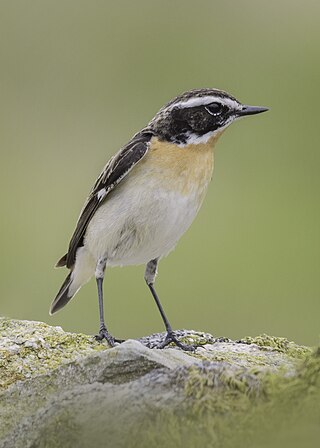
The whinchat is a small migratory passerine bird breeding in Europe and western Asia and wintering in central Africa. At one time considered to be in the thrush family, Turdidae, it is now placed in the Old World flycatcher family, Muscicapidae. Both sexes have a strong supercilium, brownish upper parts mottled darker, a pale throat and breast, a pale buff to whitish belly, and a blackish tail with white bases to the outer tail feathers, but in the breeding season, the male has an orange-buff throat and breast.

The budgerigar, also known as the common parakeet, shell parakeet or budgie, is a small, long-tailed, seed-eating parrot. Naturally, the species is green and yellow with black, scalloped markings on the nape, back, and wings. Budgies are bred in captivity with colouring of blues, whites, yellows, greys, and even with small crests. Juveniles and chicks are monomorphic, while adults are told apart by their cere colouring, and their behaviour.

The flame robin is a small passerine bird native to Australia. It is a moderately common resident of the coolest parts of south-eastern Australia, including Tasmania. Like the other two red-breasted Petroica robins—the scarlet robin and the red-capped robin—it is often simply called the robin redbreast. Like many brightly coloured robins of the Petroicidae, it is sexually dimorphic. Measuring 12–14 cm (4.7–5.5 in) long, the flame robin has dark brown eyes and a small thin black bill. The male has a brilliant orange-red chest and throat, and a white patch on the forehead above the bill. Its upper parts are iron-grey with white bars, and its tail black with white tips. Female coloration is a muted grey-brown. Its song has been described as the most musical of its genus.
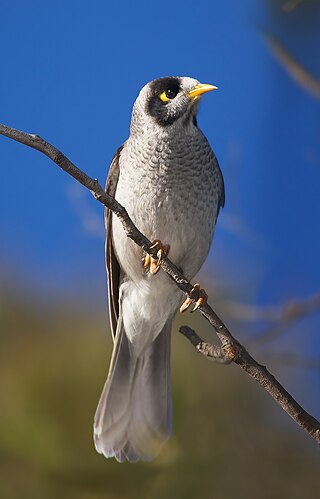
The noisy miner is a bird in the honeyeater family, Meliphagidae, and is endemic to eastern and southeastern Australia. This miner is a grey bird, with a black head, orange-yellow beak and feet, a distinctive yellow patch behind the eye, and white tips on the tail feathers. The Tasmanian subspecies has a more intense yellow panel in the wing, and a broader white tip to the tail. Males, females and juveniles are similar in appearance, though young birds are a brownish-grey. As the common name suggests, the noisy miner is a vocal species with a large range of songs, calls, scoldings and alarms, and almost constant vocalisations, particularly from young birds. One of four species in the genus Manorina, the noisy miner itself is divided into four subspecies. The separation of the Tasmanian M. m. leachi is of long standing, and the mainland birds were further split in 1999.

The orange-bellied parrot is a small parrot endemic to southern Australia, and one of only three species of parrot that migrate. It was described by John Latham in 1790. A small parrot around 20 cm (8 in) long, it exhibits sexual dimorphism. The adult male is distinguished by its bright grass-green upper parts, yellow underparts and orange belly patch. The adult female and juvenile are duller green in colour. All birds have a prominent two-toned blue frontal band and blue outer wing feathers.

The eastern bluebonnet, also known as the greater bluebonnet, is an Australian parrot, one of two species in the genus Northiella. It was originally included in the genus Psephotus but due to distinctive physical and behavioural differences was reclassified into its own genus in 1994 by ornithologists and taxonomists Christidis and Boles. The bluebonnet is a medium-sized inland parrot commonly found in the interior of southeastern and central-southern Australia. It is adapted to life in semi-arid regions but can also flourish in regions of medium rainfall towards the eastern and southern extremities of its range.

The pyrrhuloxia or desert cardinal is a medium-sized North American songbird found in the American southwest and northern Mexico. This distinctive species with a short, stout bill and red crest and wings, and closely resembles the northern cardinal and the vermilion cardinal, which are in the same genus.

The black falcon is a medium-large falcon that is endemic to Australia. It can be found in all mainland states and territories and yet is regarded as Australia's most under-studied falcon.

The crimson chat is a species of small bird found in Australia. It is also known as the tricoloured chat, saltbush canary, and crimson-breasted nun.

The brown honeyeater is a species of bird in the family Meliphagidae. It belongs to the honeyeaters, a group of birds which have highly developed brush-tipped tongues adapted for nectar feeding. Honeyeaters are found mainly in Australia, New Guinea, and parts of Indonesia, but the brown honeyeater is unique in that it also occurs on the island of Bali, making it the only honeyeater to be found west of the Wallace Line, the biogeographical boundary between the Australian-Papuan and Oriental zoogeographical regions.

The painted finch is a common species of estrildid finch found in Australia. The painted finch acquired its name due to the red and white spotted and mottled underparts of both males and females. The binomial comes from emblema meaning 'mosaic or inlaid work'; and pictum derives from the Latin word pictus, meaning 'painted'. Other names include Emblema finch, mountain finch, painted firetail and Emblema. The painted finch is a popular bird to be kept in captivity and in backyard aviaries.

The gibberbird is a species of chat within the Meliphagidae family of passerine birds.

The rufous fieldwren also known as the desert wren or sandplain wren is a species of insectivorous bird in the family Acanthizidae, endemic to Australia.
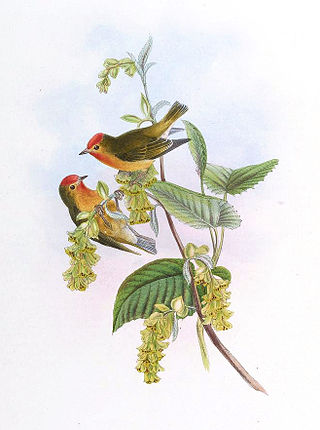
The fire-capped tit is a small, 10 cm (3.9 in) long, weighing about 7 g (0.25 oz) bird species assigned to the family Paridae, that breeds in the temperate forest bordering the Himalayas to the south, in the Hengduan Shan and Nujiang Shan on the Myanmar-China border, the Micah Shan and Daba Shan on the Northern Sichuan border. It winters down hill and further south. Further to the east, birds tend to be smaller and the plumage becomes gradually darker.
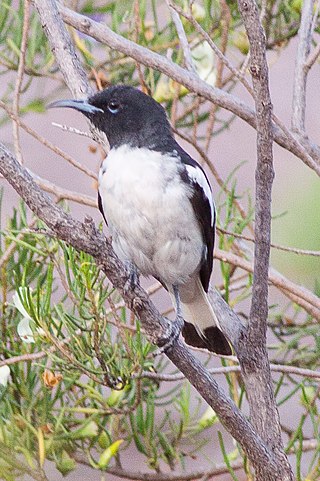
The pied honeyeater is a species of bird in the family of honeyeaters Meliphagidae and the sole species in the genus Certhionyx. This species is also known as the black and white honeyeater or western pied honeyeater.

The white-fronted chat is a species of bird in the honeyeater family Meliphagidae native to southern Australia. The male has a white face bordered by a black breast band. It is insectivorous.

Epthianura is a genus of bird also known as the Australian chats. Along with the gibberbird in the genus Ashbyia they were once thought to constitute a separate family, the Epthianuridae, although most taxonomists today treat them as a subfamily, Epthianurinae, of the honeyeater family Meliphagidae.
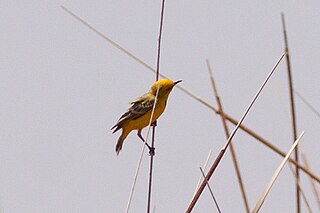
The yellow chat is a small passerine bird endemic to Australia. They are known for their remarkable adaptions that aid their survival in their arid habitat.

The crested bellbird is a medium-sized passerine bird in the family Oreoicidae. It is native to drier parts of Australia where its typical habitats are acacia scrublands, eucalypt woodlands, spinifex and saltbush plains, and dunes. The male is about 20 cm (8 in) long and has a grey head, a black crest and breast, and a grey or olive brown body. The female and juvenile are similar but the colours are more muted and the black breast is lacking. The distinctive call is a high pitched bell-like sound, audible at some distance. Sometimes a pair of birds duet.
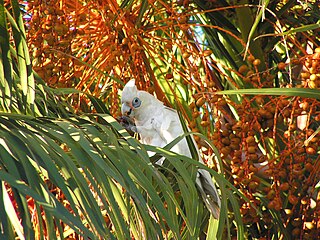
Muir's corella is a stocky, medium-sized white cockatoo endemic to Western Australia. It was the threatened nominate subspecies of the western corella. It was removed from the WA's threatened species list in November 2012 as a result of successful conservation efforts.




















